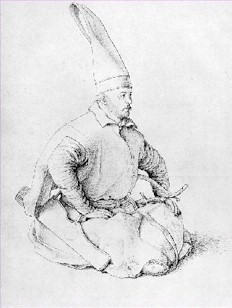 |
| Sketch of
a janissary, by Bellini c.1480 |
| A.8.a. | The Jem Affair: | |
Mehmed’s death was followed
by a bloody revolt of the Janissaries and a dangerous civil war
between his two sons, Jem and Bayezid. In fact, there was a
widespread movement of reaction against Mehmed’s centralised
policies. Jem, who was governor of Konya, had been favoured by
Mehmed as his successor, intending to follow his father’s
strict administration and conquests; Bayezid, on the other hand,
was supported by the Janissaries and other discontented factions
in a party of opposition. Jem was prevented from reaching
Istanbul and Bayezid’s accession to throne was secured in
May 1481; Jem then arrived in Bursa, proclaimed himself Sultan
and started to mint coins in his own name. He was defeated by the
Janissaries and he fled to Rhodes; Bayezid, worried about
Jem’s return, agreed to pay the Knights of St John 45,000
gold pieces a year (‘to cover Jem’s expenses’) to
hold him captive. Jem also spent seven years of internment in
France, then Rome (1489) whereupon this money passed to the pope.
Fear of Jem’s return caused Bayezid to make peace with
Hungary and Venice, the two countries most likely to lead a
Crusade against the Ottomans, meaning this was a long period of
peace. Jem died in 1495, and Bayezid continued his pacific and
tolerant approach until his death in 1512: he was praised as a
just ruler and described as ‘the Law-Abiding’. His
reign saw large-scale development of economic and commercial life
under conditions of an orderly and trustworthy administration;
important urban centres such as Istanbul, Edirne and Bursa grew
rapidly, and public buildings assumed a truly imperial grandeur
in size and artistic quality.
 |
| Sketch of
a janissary, by Bellini c.1480 |
| A.8.b. | Foreign Policy under Bayezid II: | |
Bayezid won military prestige during his 1496-8 Moldavian expedition against the Poles for influence over Moldavia, and pursued an exhausting war with the Mamluks which was essentially a struggle for control over the Turcoman tribes inhabiting the frontier region between their two empires. Sultan Qa’it Bay had in fact received Jem in 1482 and encouraged him to undertake operations in central Anatolia; hostilities broke out in 1485, and there were six major campaigns until both sides were exhausted and peace was made in 1491 on the basis of the status quo. In order to fight the Mamluks, Bayezid needed peace in the West and thus pursued close diplomatic relations with the Italians and papacy, even forming a rapprochement with them in 1494 against King Charles VIII of France.
However, Venice formed an alliance with France in 1497, and Milan, Ferrara, Mantua and Florence applied to Bayezid for help: the Ottoman state thus became an essential factor in European diplomacy and they embarked on an unprecedented naval construction programme. This led to a second war with Venice in 1499-1502, and marked the beginning of Ottoman supremacy in the Mediterranean and in European politics.
Back in Anatolia, tribes of Turcoman nomads revolted against the control imposed on them by the increasingly centralised administration, which attempted to register them in a census for the purpose of paying taxes. These tribes also tended to favour Sufism over the strict imposition of Sunni Islam and Shari’a by the Ottoman regime, and in the early C15th had given their allegiance to the founder of the Shi’i Safavid dynasty (1499–1736), Shah Isma’il, who became their spiritual and political leader in 1501: the tribes came to be known as the Kizil Bash (Persianised as Qizilbash) because of their Red Heads (they wore red hats). Isma’il was thus a dangerous rival to the Ottomans, and as he also claimed the title of ghazi he was their rival in the pursuit of Holy War against infidels. He tried to conclude a military alliance with Venice, and made incursions into Ottoman territory in 1502 and 1507.